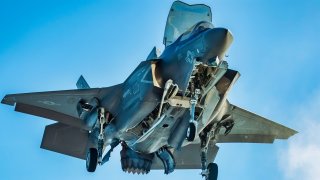The U.S. Military Needs the F-35 Fighter To Be a Success
The F-35 Lighting II is a magnificent aircraft with unmatched capabilities. But to ensure that the fighter jet's impressive technology makes the difference in a potential future conflict, Lockheed Martin and the Pentagon need to sort out the production problems that trouble the F-35 program.
Summary: Amid escalating competition with China, the U.S. military prepares for potential conflict in the Indo-Pacific, with the advanced F-35 Lightning II playing a crucial role. However, production delays, particularly between the TR-3 update and the Block 4 upgrade, threaten its deployment. Lockheed Martin produces about 156 aircraft annually but faces delays due to manpower and resource shortages, affecting the fighter's enhanced capabilities. Despite delivering 98 jets in 2023, up to 60 are in storage awaiting updates. The Pentagon may accept less advanced versions temporarily, but resolving these delays is vital for maintaining technological superiority in future conflicts.
America Needs the F-35
Competition with China is at an all-time high. Beijing continues to invest large sums in its military forces with the ultimate goal of replacing the U.S. as the world's superpower. With this important consideration in mind, the U.S. military is getting ready for a potential conflict in the Indo-Pacific. In the vast expanses of the area of operations, ships and aircraft will play a leading role in a war with China.
As the most advanced fighter jet in the world, the F- 35 Lighting II will play a major role in the fighting. However, delays in the production could limit the Air Force's choices with regard to the 5th-generation stealth fighter jet.
F-35 Lighting II Production
Delivery of the aircraft is stuck between the TR-3 update and the Block 4 upgrade that will introduce new technology to the already advanced fighter jet. Lack of manpower and resources are holding back the TR-3 updates, threatening the timeline of the more important Block 4 (Block 4 needs the TR-3 in place).
Lockheed Martin is churning out aircraft as planned (approximately 156 per year), and it expects to keep up that rate of production through the next four years. But without the software updates, they are of more limited use.
In 2023, Lockheed Martin delivered 98 fighter jets, all in the TR-2 configuration, but stored up to 60 aircraft until the TR-3 update issues were sorted out. The F-35 Joint Program Office is careful not to reveal the exact number of aircraft currently in storage awaiting the TR-3 updates for operational security reasons.
The demand is so great that the Pentagon and foreign partners of the F-35 program are considering accepting aircraft with the TR-2 configuration as an emergency move until the issue with the TR-3 updates is sorted out.
“Any aircraft involved and delivered as part of the truncation plan will provide valuable capability to the warfighters while TR-3 completes final verification and validation,” an official from the Joint Program Office said.
But Jim Taiclet, Lockheed Martin’s president, chairman, and chief executive officer, believes that by the summer, the TR-3 will be ready and certified, unblocking production.
“We’re actually flying, now, the TR-3 software for production aircraft in Fort Worth. We’ve got 20 production flights under our belt, as we begin the acceptance process in Fort Worth, with the new software version entering production this month,” Taiclet said in a recent earnings call.

The TR-3 update will improve the aircraft’s onboard digital infrastructure (data storage and processing) and make the pilot user interface better. In addition, the new software will enable the F-35 to carry new air-to-air and air-to-ground munitions, as well as advanced sensors and cyber capabilities.
With several countries awaiting aircraft and new partners about to enter the F-35 program, it is paramount that fighter jets are getting delivered.

The F-35 Lighting II is a magnificent aircraft with unmatched capabilities. But to ensure that the fighter jet's impressive technology makes the difference in a potential future conflict, Lockheed Martin and the Pentagon need to sort out the production problems that trouble the F-35 program.
About the Author
Stavros Atlamazoglou is a seasoned defense journalist specializing in special operations and a Hellenic Army veteran (national service with the 575th Marine Battalion and Army HQ). He holds a BA from Johns Hopkins University and an MA from the Johns Hopkins School of Advanced International Studies (SAIS). His work has been featured in Business Insider, Sandboxx, and SOFREP. Email the author: [email protected].


